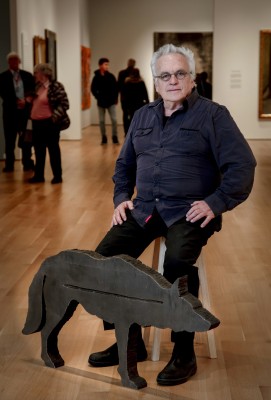Face off
Canadian sculptor John McEwen discusses the line that many fear to cross in the AGO’s McLean Centre for Indigenous & Canadian Art.

Rounding the corner of the J.S. McLean Centre for Indigenous & Canadian Art, there’s a line many visitors hesitate to cross. It’s an invisible line cutting diagonally across the gallery floor, anchored on either end by two low steel sculptures affixed to the floor. Even without eyes, these minimalist silhouettes have an unmistakably canine presence: a pair of life-sized wolves, locked in opposition. Entitled The Distinctive Line Between One Subject and Another (1980), this work by Toronto-born artist John McEwen is on view now on Level 2.
We sat down with John, a co-founder of the legendary A Space Gallery in Toronto and a recent recipient of the Order of Canada, to find out more about this mesmerizing work and what those wolves are really thinking.
AGO: Why do you think people hesitate to cross that invisible barrier between the two wolves?
John: For me, there is certain aggression
AGO: Locked in their opposing corners, the wolves seem oblivious to anything but each other. Do you know what they’re thinking?
John: Animals have the ability to spark something vital in our imaginations. I doubt we can ever know what these wolves are thinking. My minimalist approach, here and in other works, is an attempt to keep the mystery of the animal world alive and fresh in our minds. These wolves are magic because they are simultaneously real and unreal. They are unreal in the sense that they are merely objects, mute and immobile, flame cut from steel and weighing over 250 pounds each. On the other hand, for the museum visitor, to be walking through the AGO and to see these animals suddenly appear, so unexpectedly and with so little evidence, is also a kind of magic.
AGO: Did you always know that you would be a sculptor?
John: It took me to two years to get into the Ontario College of Art because I couldn’t draw. So I went to McMaster University for a year, met a girl who lived on a farm and began making things out of broken farm machinery. I knew then that sculpture was how I could understand the world.
Don’t miss this and other exciting works on view now in the J.S. McLean Centre for Indigenous
& Canadian Art, free with General Admission.
Are you an AGOinsider yet? If not, sign up to have stories like these delivered straight to your inbox every week.

